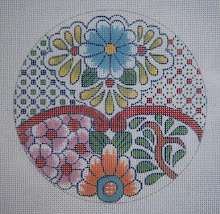 I used all three names applied to this textile - stripes intersecting at right angles to form a delightful pattern (I explained the origin of the terms in a previous post back a while.)
I used all three names applied to this textile - stripes intersecting at right angles to form a delightful pattern (I explained the origin of the terms in a previous post back a while.) This one is what we in this country call "Gingham," a woven fabric (replicated in needlepoint here) with even stripes on both warp and weft - and just one color plus white, creating a lighter shade of the color where it crosses.
The arrow is pointing to a place where one has to be careful when stitching on a rounded outline. It's necessary to pay attention!!
Feeling rather lazy the day I needed to start this, instead of cutting a new square of canvas, I Ipicked up a small piece of canvas that already had a 3 3/4" circle drawn on it, and decided it would be a great exercise anyway in stitching needlepoint plaid.
 The circle is drawn on an odd count, which meant I couldn't make stripes of 4 threads. Three were too small for the scale of this piece, and 7 were too wide.
The circle is drawn on an odd count, which meant I couldn't make stripes of 4 threads. Three were too small for the scale of this piece, and 7 were too wide. There is a lot more to using plaid for needlepoint than just "setting it up." One has to consider the intended use for a particular project, and make sure the scale is also attractive. The 5 threads I settled on look right for the circle.
The next consideration was where to start. On a rectangle, I would have started stitching the warp on the right side - however, on this circle, I began in the center, as I am a perfectionist about symmetry. (The circle is stich drawn for this reason) From the center, I simply worked out toward the right side.
The arrow pointing to the center shows where one could draw a well centered letter or monogram if desired (before stitching).
 Next, I started stitching the weft - again centering it. The arrows point to the center thread.
Next, I started stitching the weft - again centering it. The arrows point to the center thread. After this, it had to be marked for guidance, so I used the Sharpie extra fine Permanent MARKER - never the paint pen, as it's not really safe for needlepoint canvas.
 I counted backward from the center to reach the top where I began the stitching. The marks on this circle didn't go into the circle itself as I do on squares - it would have made the outline difficult to discern.
I counted backward from the center to reach the top where I began the stitching. The marks on this circle didn't go into the circle itself as I do on squares - it would have made the outline difficult to discern.
The arrows point to a place that looks rather strange - but it's just the white stitches making the "gap." This won't show when it's finished.

The last picture shows the progress toward looking like gingham!! Again, the arrows point to places where it appears that a little bite has been take out of the circle. The tendency would be to want to complete the blue square - but then it wouldn't be correct according to the circle drawing. A round piece this small could be a box top insert - but I think I would have started with a monogram before beginning the stitching!
ADDENDUM: I have several tutorials on the subject of stitching plaid in needlepoint, but for anyone who has missed it; the WARP (vertical) stripes are stitched first, and in basketweave, on every other row. Use the warp threads of the canvas - the thread is on top, forming a slight "bump." Then the weft is worked horizontally on the weft threads of the canvas - where the spaces are left. This is extremely simple, and there is minimal distortion of the canvas.

No comments:
Post a Comment